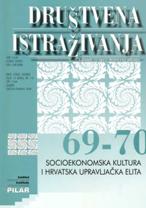Posavsko pogranično područje Hrvatske i Bosne i Hercegovine: razvoj do 1918. godine (s posebnim osvrtom na promjene etničkog sastava)
The Posavina Border Region of Croatia and Bosnia-Herzegovina: Development up to 1918 (with special reference to change in ethnic composition)
Author(s): Ivan CrkvenčićSubject(s): Social Sciences
Published by: Institut društvenih znanosti Ivo Pilar
Keywords: ethic change; middle ages; military frontier; Posavina Region
Summary/Abstract: After dealing with the natural features and social importance of the Posavina region in the past, presented is the importance of this region as a unique Croatian ethnic territory during the Middle Ages. With the appearance of the Ottomans and especially at the beginning of the 16th century, great ethnic changes occured, primarily due to the expulsion of Croats and arrival of new ethnic groups, mostly Orthodox Vlachs and later Muslims and ethnic Serbs. With the withdrawal of the Ottomans from the Pannonian basin to the areas south of the Sava River and the Danube, the Sava becomes the dividing line creating in its border areas two socially and politically different environments: the Slavonian Military Frontier on the Slavonian side and the Ottoman military-frontier system of kapitanates on the Bosnian side. Both systems had a special influence on the change of ethnic composition in this region. With the withdrawal of the Ottomans further towards the southeast of Europe and the Austrian occu-pation of Bosnia and Herzegovina the Sava River remains the border along which, especially on the Bosnian side, further changes of ethnic structure occured.
Journal: Društvena istraživanja - Časopis za opća društvena pitanja
- Issue Year: 13/2004
- Issue No: 69+70
- Page Range: 293-314
- Page Count: 22
- Language: English

